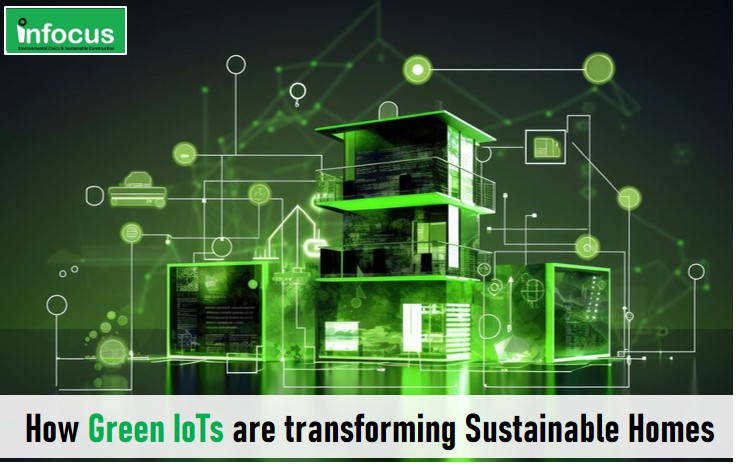In recent years, the integration of the Internet of Things (IoTs) into our daily lives has revolutionized various sectors, from healthcare to agriculture. Among these, the concept of Green IoTs are making significant strides in promoting sustainable living, particularly within our homes. Green IoTs refer to the use of IoT technologies to reduce energy consumption and environmental impact. Green IoTs encompass a diverse array of applications with far-reaching implications for sustainable homes. This transformation is reshaping how we think about sustainability, energy efficiency, and environmental stewardship in residential settings.
Green IoTs in Homes:
The Internet of Things (IoT) has played a pivotal role in making homes, and a wide of range of devices smarter and more sustainable. Continued advancements in IoTs are also making these same things greener by enhancing energy efficiency. Green IoTs, which utilize IoT capabilities to optimize smart home energy consumption through a multi-pronged approach. Parts of this approach include employing advanced thermostats that utilize mesh networked sensors for more precise heating and cooling control, implementing weather-monitoring irrigation systems powered by renewable energy sources to maximize lawn and garden watering, and fine-tuning electric vehicle (EV) charging schedules to minimize peak-hour energy consumption.
The drive to decrease energy consumption is fueling adoption of Green IoT technology across a range of sectors. Through, smart grids, water conservation systems, advanced waste management, and indoor air quality monitors, IoT technology is empowering homeowners to live more sustainably and reduce their environmental footprint.
Energy Efficiency and Smart Grids:
One of the most impactful applications of Green IoTs in sustainable homes are energy management. Smart grids, equipped with IoT sensors and devices, allow homeowners to monitor and optimize their energy usage in real time. These systems can automatically adjust lighting, heating, and cooling based on occupancy and time of day, significantly reducing energy waste. For instance, smart thermostats like Nest by Google learns user behaviors and adjust temperatures accordingly, cutting down unnecessary energy consumption.
Furthermore, smart grids enable the integration of renewable energy sources such as solar panels and wind turbines. By using IoT-enabled devices to manage the energy produced and consumed, homeowners can maximize the efficiency of these renewable resources, store excess energy, and even contribute to the grid. This not only reduces reliance on fossil fuels but also promotes a more sustainable and resilient energy infrastructure.
Water Conservation:
Water is another critical resource where Green IoT is making a substantial difference. Smart irrigation systems, for example, use weather data and soil moisture sensors to optimize watering schedules, ensuring that gardens and lawns receive the right amount of water at the right time. This prevents overwatering and reduces water waste, which is particularly important in areas prone to drought.
Inside the home, smart water meters and leak detection systems can monitor water usage and detect leaks early. These devices alert homeowners to unusual water patterns, helping to prevent water damage and conserve this precious resource. By providing detailed insights into water usage, Green IoT devices empower residents to make informed decisions about their water consumption habits.
Waste Management and Recycling:
Green IoTs are also revolutionizing waste management and recycling efforts in sustainable homes. Smart waste bins equipped with sensors can sort recyclables from non-recyclables, reducing contamination and improving recycling rates. These bins can also monitor fill levels and schedule pickups only when necessary, optimizing waste collection routes and reducing the carbon footprint of waste management services.
Moreover, IoT-enabled composting systems can track and manage organic waste, turning kitchen scraps into valuable compost for gardens. By integrating these systems with smart gardening tools, homeowners can create a closed-loop system that minimizes waste and promotes sustainable living practices.
Indoor Air Quality and Health:
Maintaining a healthy indoor environment is essential for sustainable living, and Green IoT plays a crucial role in this area. Smart air quality monitors can detect pollutants, allergens, and humidity levels, providing real-time data to homeowners. These devices can be integrated with HVAC systems to ensure that air filtration and ventilation are optimized, creating a healthier indoor environment.
In addition, smart home systems can be programmed to reduce the use of harmful chemicals and promote natural cleaning products. For example, IoT-enabled cleaning robots can be guided to use eco-friendly solutions, ensuring that the home remains clean without compromising the environment.
Future Prospects:
The future of Green IoT in sustainable homes looks promising, with advancements in technology paving the way for even more innovative solutions. As artificial intelligence and machine learning algorithms become more sophisticated, IoT devices will be able to make even smarter decisions about resource management, further reducing environmental impact.
Moreover, the growing trend of smart cities, where entire communities are interconnected through IoT, will amplify the benefits of Green IoTs on a larger scale. Sustainable homes will not only contribute to individual well-being but also play a crucial role in achieving broader environmental goals. As technology continues to evolve, the potential for Green IoTs to create more sustainable, resilient, and eco-friendly homes will only grow, making it an essential component of the future of sustainable living.
By
Editorial, Infocus



